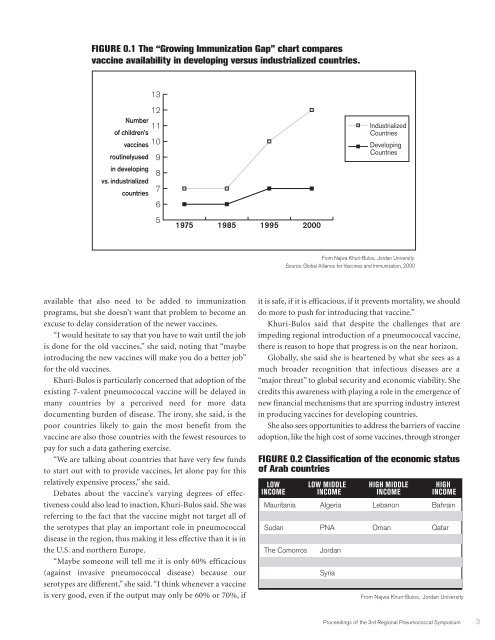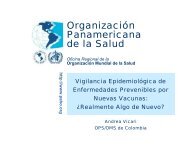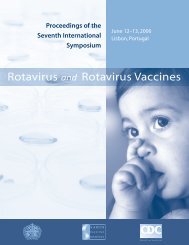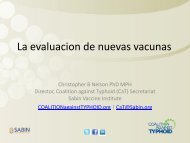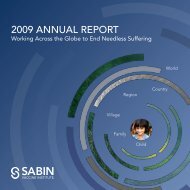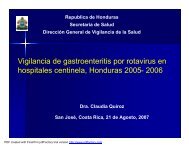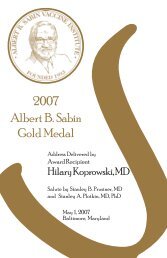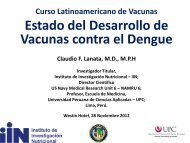3rd Pneumococcal Symposium web - Sabin Vaccine Institute
3rd Pneumococcal Symposium web - Sabin Vaccine Institute
3rd Pneumococcal Symposium web - Sabin Vaccine Institute
Create successful ePaper yourself
Turn your PDF publications into a flip-book with our unique Google optimized e-Paper software.
FIGURE 0.1 The “Growing Immunization Gap” chart compares<br />
vaccine availability in developing versus industrialized countries.<br />
13<br />
12<br />
Number<br />
11<br />
of children’s<br />
vaccines 10<br />
routinelyused 9<br />
in developing<br />
8<br />
vs. industrialized<br />
7<br />
countries<br />
6<br />
Industrialized<br />
Countries<br />
Developing<br />
Countries<br />
5<br />
1975<br />
1985<br />
1995<br />
2000<br />
From Najwa Khuri-Bulos, Jordan University<br />
Source: Global Alliance for <strong>Vaccine</strong>s and Immunization, 2000<br />
available that also need to be added to immunization<br />
programs, but she doesn’t want that problem to become an<br />
excuse to delay consideration of the newer vaccines.<br />
“I would hesitate to say that you have to wait until the job<br />
is done for the old vaccines,” she said, noting that “maybe<br />
introducing the new vaccines will make you do a better job”<br />
for the old vaccines.<br />
Khuri-Bulos is particularly concerned that adoption of the<br />
existing 7-valent pneumococcal vaccine will be delayed in<br />
many countries by a perceived need for more data<br />
documenting burden of disease. The irony, she said, is the<br />
poor countries likely to gain the most benefit from the<br />
vaccine are also those countries with the fewest resources to<br />
pay for such a data gathering exercise.<br />
“We are talking about countries that have very few funds<br />
to start out with to provide vaccines, let alone pay for this<br />
relatively expensive process,” she said.<br />
Debates about the vaccine’s varying degrees of effectiveness<br />
could also lead to inaction, Khuri-Bulos said. She was<br />
referring to the fact that the vaccine might not target all of<br />
the serotypes that play an important role in pneumococcal<br />
disease in the region, thus making it less effective than it is in<br />
the U.S. and northern Europe.<br />
“Maybe someone will tell me it is only 60% efficacious<br />
(against invasive pneumococcal disease) because our<br />
serotypes are different,” she said. “I think whenever a vaccine<br />
is very good, even if the output may only be 60% or 70%, if<br />
it is safe, if it is efficacious, if it prevents mortality, we should<br />
do more to push for introducing that vaccine.”<br />
Khuri-Bulos said that despite the challenges that are<br />
impeding regional introduction of a pneumococcal vaccine,<br />
there is reason to hope that progress is on the near horizon.<br />
Globally, she said she is heartened by what she sees as a<br />
much broader recognition that infectious diseases are a<br />
“major threat” to global security and economic viability. She<br />
credits this awareness with playing a role in the emergence of<br />
new financial mechanisms that are spurring industry interest<br />
in producing vaccines for developing countries.<br />
She also sees opportunities to address the barriers of vaccine<br />
adoption, like the high cost of some vaccines, through stronger<br />
FIGURE 0.2 Classification of the economic status<br />
of Arab countries<br />
LOW LOW MIDDLE HIGH MIDDLE HIGH<br />
INCOME INCOME INCOME INCOME<br />
Mauritania Algeria Lebanon Bahrain<br />
Somalia Egypt Libya Kuwait<br />
Sudan PNA Oman Qatar<br />
Yemen Iraq Saudi Arabia UAE<br />
The Comorros Jordan<br />
Djiboti Morocco<br />
Syria<br />
Tunis<br />
From Najwa Khuri-Bulos, Jordan University<br />
Proceedings of the <strong>3rd</strong> Regional <strong>Pneumococcal</strong> <strong>Symposium</strong> 3


